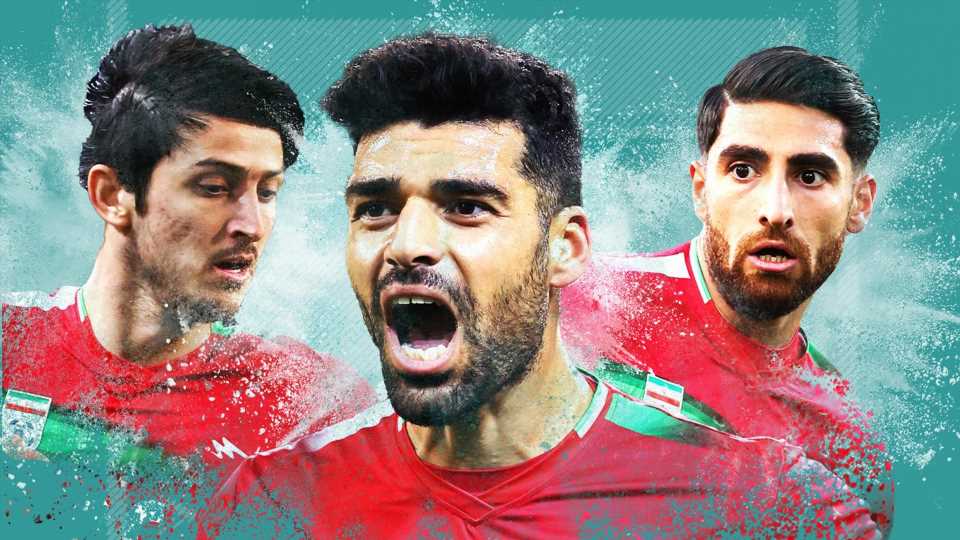IRAN have qualified for five previous World Cup editions, including three of the last four, but have never made it into the knockout rounds.
The last two World Cup tournaments that Iran qualified for were in 2014 and 2018, so this winter will be the third on the bounce.
In all three, Iran were and will be guided by the former Manchester United assistant manager Carlos Queiroz who won two Premier League titles and even theChampions League alongside the great Sir Alex Ferguson.
However, Queiroz didn’t actually lead Iran to qualification this time around.
From 18 matches, the Portuguese’s predecessor Dragan Skocic won 15 matches to lead the Middle Eastern team to the coveted competition.
In the summer, Skocic was dismissed after losing two of their last three matches before being reinstated by the Iranian FA for two months.
Read more world cup stories
Meet the World Cup WAGS – from a karate expert to stunning Miss Belgium
Piers Morgan selects Cristiano Ronaldo to lead his Dream Team World Cup XI
The Croatian coach was then relieved of his duties once more, with Queiroz being reinstated as the manager in what was one of the most peculiar pre-tournament sackings since Julen Lopetegui’s painstaking departure from Spain in 2018.
Nevertheless, having been drawn into a relatively difficult group alongside England, Wales and the USA, Iran may fancy their chances in at least two of those matches.
Predicted Starting XI
Predicting the starting lineup that Queiroz will look to use in the World Cup was extremely difficult given that the 69-year-old has been in charge for very little time — two matches overall, both of which were friendlies.
Most read in Football
Rooney breaks silence after Ronaldo brands ex-Man Utd team-mate a 'rat'
Watch Xmas revamp of Three Lions ahead of England's Qatar World Cup bid
Tributes as ex-Austrian international, 57, dies after being hit by train
Ronaldo offered shock Man Utd transfer exit by Australian football chief
However, from these games, it became apparent that Queiroz favoured the deployment of the 4-1-4-1 with a number ‘6’ protecting the space between the backline and the more advanced midfielders.
Of course, this is just the shape out of possession as when Iran are on the ball, the wingers push higher, holding the width to create a typical 4-3-3 attacking structure.
Attacking Phase
Iran are not a possession-oriented side, unlike England and the USA in the same group.
Their style of play is much closer to that of Wales.
Queiroz’s side are flexible with their attacking approach, which is potentially the best way to describe it.
This means that not only can Iran hold possession and attempt to build their way through the thirds of the pitch, but they can also drop deeper to drag the opposition up the pitch before hitting them on the break.
The different tactics depend on the opponent on the day.
For instance, in Iran’s two recent friendlies against both Uruguay and Senegal, the team played very different in each match.
Versus Senegal, Queiroz’s men were holding their compact shape while the African nation dominated the ball.
Meanwhile, against the South Americans, Iran had much more possession and were allowed to build up from the back due to Uruguay’s lack of pressing.
When Iran do play out from the back, the set-up is rather conventional as Queiroz is not looking to reinvent the wheel, but to merely make sure it turns.
The fullbacks stay relatively low to provide wide support for the centre-backs in case the ball needs to be circulated out wide. Furthermore, the central defenders split wider which allows the single pivot to drop in and out of the backline.
Unfortunately, for a country like Iran, passing out through the pivot is extremely difficult. It requires a high level of technical ability from the midfielders whereas Queiroz prefers his ‘6’ to possess more defensive acumen than attacking proficiency.
Former Reading player Saeed Ezatolahi has been the pivot in each game for Team Melli so far and has resembled a midfielder who is far better out of possession than on the ball.
Tasked with being the link man from defence to attack, the previous image portrays all of Ezatolahi’s passes under Queiroz across the two international friendlies he has been in charge of. The Iranian midfielder has primarily played squared passes or more direct passes into the channels, offering little to no central penetration through the lines.
Knowing that they perhaps don’t possess the required technical nous to build up through the pivot, Iran tend to combine on the flanks in order to progress the ball from deeper areas of the pitch.
The 4-1-4-1/4-3-3 offers the perfect opportunity for wide overloads and combination play to naturally formulate as shown in this example.
With the move having been initiated by the right centre-back, Iran’s right-winger, right-back and right central midfielder all combine to break through Uruguay’s mid-block into the space behind.
The side’s average possession shape also shows this. Look out for how congested the wide areas are and how much stronger the links are on the flanks as opposed to the middle of the pitch:
Iran are really vertical with their play. Queiroz is not a major fan of having his players hold onto the ball for long periods of time.
This increases the possibility of mistakes in dangerous areas. Instead, the experienced coach instructs his men to always look for the first pass forward where they can penetrate the opposition’s defence with runners in behind.
This means that the centre-forward must always be occupying the centre-backs and causing havoc by playing off the shoulder, while the players under the ball have to look as far as possible to try find him.
32-year-old Karim Ansarifard has performed this role well so far for Iran and has offered both depth and physicality when challenging in the air for flick-ons and second balls.
Defensive Phase
Out of possession, Iran are dogged. Queiroz shows his true Portuguese pragmatism and wants his side to be very disciplined out of possession.
However, that doesn’t mean that the nation must be wasteful in possession and revert into a deep defensive block when on the back foot.
Team Melli do press high up the pitch and look to win the ball back as close to the opponent’s goal as possible.
Queiroz instructs his players to apply a mix of a zonal and man-marking pressing structure.
This means that from the get-go, Iran, using the centre-forward as an initiator, will force the attacking team into one half of the pitch where they will then go man-to-man, using the touchline as an extra defender to try and regain possession.
In Queiroz’s two games in charge thus far, the side have registered 19 ball recoveries in the opposition’s half, showing that they do in fact like to press high.
Lower down the pitch, though, the shape does become far more compact. There is less intention to win the ball as there is to remain narrow between the lines, giving the opposition no space to play within Iran’s defensive block.
Since Queiroz has been using a 4-3-3 in possession, the block reverts into a tight 4-1-4-1 with the wingers dropping back and the number ‘6’ operating in a zonal role, picking up any players that drift into the space between the midfield and backline.
The objective in this phase is to keep the opposition players from reaching anyone inside the block, ensuring that play is always circulating either out wide or in front of the defensive unit where it can be contained.
However, this is something that Iran have not quite mastered just yet. In the two friendly games so far during the 69-year-old’s tutelage, Senegal and Uruguay were finding it far too easy to reach their best players between the lines and create dangerous chances.
If Iran are to stifle England, Wales and the USA’s best attackers who operate in these spaces, they need to be much more compact and cooperative with one another.
Transitions
During attacking transitions, Iran can be rather dangerous, especially when the team are sitting deeper against a more possession-oriented opponent and are waiting for the right moment to pounce with a counterattack.
When Team Melli break, they want to be as direct as possible with their attacking transitions, looking to play to the feet of the centre-forward who drops short instantly, dragging defenders out of position and allowing runners to move into the space he has vacated.
Nevertheless, it is during defensive transitions that Iran struggle so much.
This comes back to the lack of energy in the midfield area, primarily due to the fact that the squad is ageing and has very little youth, particularly in the middle of the park.
During Queiroz’s short-reigned second spell, there were several key moments, particularly against the technical dribbling quality and blistering speed of Senegal’s attack, where the players were carved open by counterattacks in the midfield.
Here, Iran’s midfield and backline stepped up to counterpress after the side lost the ball.
The counterpressing was far too lethargic and so, Senegal played through it easily.
From there, the African nation were given most of the pitch to brear down on goal against just the Iranian centre-backs.
Moments like this must be curtailed if Iran are to have any chance at all to survive in the group with England, Wales and the USA.
Defenders
The backline is where Iran may struggle the most in terms of quality.
Guys like Shojae Khalilzadeh and Ehsan Hajsafi could provide much-needed experience at the back on such a grand stage but would leave the team lacking a lot of pace in the defensive line that England, Wales and the USA could exploit with runners in behind.
Mohammad Kanaani and Sadegh Moharrami will be tasked with providing the pace at the back alongside the two veterans, but the side’s poor goals-conceded record may hamper their progression from the group phase and put a lot of the burden of qualifying for the knockouts on the forward line.
Midfielders
The former Reading midfielder Saeed Ezatolahi is undoubtedly Iran’s best defensive player in the middle of the park.
The 26-year-old will be integral to breaking up play and protecting the space between the lines for Queiroz in his 4-1-4-1 as the number ‘6’.
Ezatolahi could also be vital for Iran in the attacking phases at finding runners in behind the backline, something he has been tasked with doing so far under Queiroz in his second spell.
Providing Ezatolahi performs his role well, it could free up both Saman Ghoddos and Milad Sarlak to help the team move the ball forward in more attacking areas.
Meanwhile, Iran have experienced heads like Vahid Amiri and Omid Ebrahimi who can come on from off the subs bench to provide some calmness to the side.
Attackers
Mehdi Taremi will be vital for Iran this winter. The FC Porto striker has been in incredible form for his club and the national side will be hoping this translates onto the pitch in Qatar at the World Cup.
However, Iran can also call upon the help of Karim Ansarifard who has been performing very well for Omonia Nicosia in Cyprus.
Many will have caught a glimpse of the 32-year-old during Omonia’s home and away matches versus Manchester United in the Europa League where he caused trouble to the Red Devils’ backline on numerous occasions and even scored in the home fixture.
Furthermore, Team Melli have players such as Feyenoord’s wide-man Alireza Jahanbakhsh, formerly of Brighton and Hove Albion in the Premier League.
Capable of playing on the right and left, Jahanbakhsh could be crucial for the Iranians, even if it is off the bench as an impact substitute.
Key player
With it being touch-and-go about whether or not Sardar Azmoun will make it to the World Cup this winter, we have decided to select FC Porto star Mehdi Taremi as the star performer for Iran ahead of the coveted competition.
Taremi has been in flying form for the Portuguese champions and is one of the top goalscorers in the Primeira Liga right now. Looking at his metrics, it’s easy to see why the 30-year-old will be integral for Team Melli under Queiroz.
Having been used as a winger so far under the Portuguese coach, Taremi can play anywhere along the frontline, although he is strongest up front.
Not only are the striker’s attacking metrics exceptional, but also his defensive stats, showing that the experienced number ‘9’ will be useful when his side are out of possession at pressing and intercepting the opposition’s passes.
If Iran are to defy the odds and progress from the group phase, they will need Taremi to be on top form.
Tournament Prediction
To progress from a tough group Iran need to be unbreakable, defensively, in each game.
Team Melli simply cannot go toe-to-toe with these three nations who possess some of the most decorated players in Europe, including multiple Champions League winners as well as serial title collectors.
Read More on The Sun
Every iPhone owner urged to check hidden codes in model number
I’m A Celeb fans share concerns that star ‘wants out’ after trial ‘fix’ row
In order to cause damage, Iran will need to do what they do best; soak up pressure, hit the opposition on the break, and when they are in the attacking phases, play as vertical as possible.
However Iran lack the quality required to get out of such a difficult group and so, will likely finish bottom of the quartet.
For even more detailed analysis of all 32 teams in the FIFA World Cup 2022, download your copy of the November Total Football Analysis magazine here
Source: Read Full Article

















